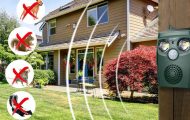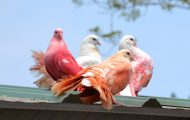Farms and barns are paradise to various animals, including the destructive pigeons. Controlling this bird is tricky since pigeons can be clever and they arrive in flocks. Although the sight of birds in a wide barn is like a scene from the movies, the damages are far from the fancy view. Pigeon droppings will smell and damage barn houses. Knowing how to get rid of pigeons in a barn is quite tricky, but our tips here will help.
The nature of pigeons
Pigeons usually flock in 10 to 30 birds. A single flock can leave an invasive and smelly amount of droppings on a barn. This can kill vegetation and damage crops, leading to lower yields and financial losses.
Pigeons are considered as large doves. However, they are far more destructive. Also, pigeons aren’t aggressive like seagulls, but they can cause expensive damages to farms and agricultural buildings.
When the pigeon’s droppings are left sitting on a barn’s roof and sidings, it will start to have a chemical reaction. It will rot the wood and jeopardize the structural integrity of the structure in the long run if the bird infestation isn’t controlled.
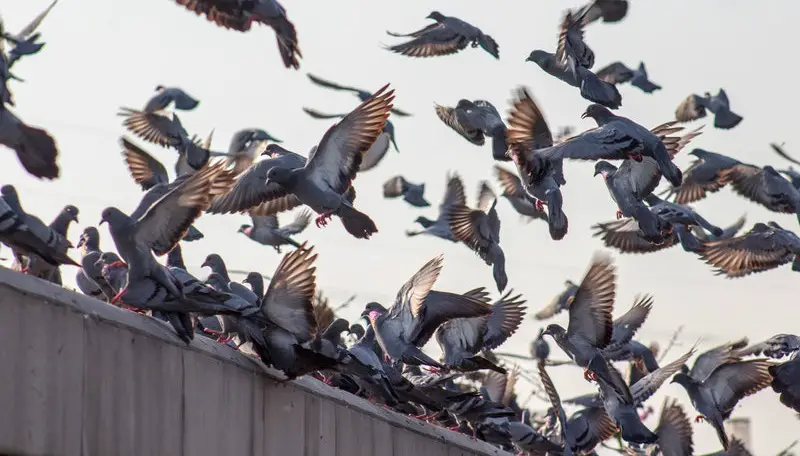
Why pigeons are attracted to barns
One of the leading reasons why pigeons flock and invade barns is the source of food. A lot of barn owners set up feeders. As much as the intention is to feed beneficial birds, pigeons don’t have much modesty. They will feed on it and keep coming back once they got accustomed to the feeding practice.
Also, indirect food sources like leftover grains and stagnant water encourage pigeons to keep coming back to the barn. Removing these food sources or limiting the pigeons’ access to the area is the key to stop the bird invasion.
If the barn doesn’t have any bird scare, it makes an ideal place for nesting and roosting. Soon enough, large flocks of pigeons will inhabit the area. This will be more difficult to control and it will take a serious bird proofing approach with the help of professionals.
Overall, pigeons invade barns to feed on spilled grains and unkempt food sources where they can peck in. As the owner, you have full control over this aspect. If you’ve cleaned the area and the pigeons are still flocking in, you can employ the control methods we’ve discussed here.
Killing pigeons isn’t the answer
According to the Migratory Bird Treaty Act of 1918, it’s illegal to kill or disturb the nesting site of any native bird. A big exception to this is feral pigeons since they are non-native in the United States.
As much as you’re free to kill pigeons according to federal law, some states impose their local rules. Some see it as animal cruelty while others allow poisoning, but not shooting. In order states, they practice pigeon shooting as a sport and therefore considered legal.
Although you can kill pigeons, it’s not a guaranteed solution to the problem. More birds will flock and invade your barn. Yet here you are, endlessly culling the destructive fowls.
Trapping and culling are no exception. As much as you can make a small dent on the pigeon population, it can easily be replaced by new offsprings.
Aside from that, killing the pigeons means you’d have to retrieve the body and dispose of it. It adds up to the chore of dealing with the invasive birds. If you fail to remove the dead birds, it will rot and cause an unbearable smell in your yard. In fact, it will attract other pests like rodents and other predator birds.
Shooting and poisoning pigeons are an endless cycle. What you need to do is to discourage the birds from roosting and landing on your barn. That way, you wouldn’t have to deal with dead bodies and manually culling the birds.
Threats that pigeons to farms
Pigeons are not aggressive birds, but they can be destructive over time. You can easily scare them, but once these birds get used to the place, it will be a challenge to drive them away.
To give you a bigger picture, here are some of the potential threats that pigeons may bring to your barn:
🕊️Reduced yields
Pigeons will directly damage the crops on your barn. Also, it will affect the livestock with the droppings that could contain communicable diseases. As much as it’s rare for fowl diseases to transfer on livestock, it can still contaminate the food of the animals.
This will lead to poor yields, which will impact the financial standing of the barn owner. Aside from that, the owner has to spend on other pigeon damages on the structure and other parts of the farm.
🕊️Contamination from droppings
Pigeons can contaminate water and food sources not just of animals, but also of humans. As much as fresh droppings may not always pose harm, its acidic characteristics can threaten the health of the people who will get exposed to it.
🕊️Financial losses
Aside from the affected yields, the barn owner will lose money from repairing the damages caused by the pigeons. If the birds aren’t controlled right away, the expenses will become more exorbitant as months pass by.
Control methods
When it comes to pigeons, there are a lot of control methods you can use. These birds are easy to scare, but you need variations to keep them from outgrowing your scare tactics.
Below, we listed possible solutions you can use without harming the pigeons. It’s up to you to choose which one works best for your barn. For the best results, you can combine any of these methods.
🕊️Visual deterrents
Visual deterrents like shiny rods, scare tapes, decoy predators, and the likes can help scare pigeons away. It has to be placed strategically and all over the barn.
The challenge with visual deterrents is that you should vary the position of each one, so the pigeons won’t recognize that these are just fake scares.
The old-school scarecrow doesn’t grow old. You can place multiple scarecrows all over the barn and your crops to discourage from roosting and feeding on it.
Scare tapes are classic and very useful. You can tie it around your crops. Once the sunlight hits the shiny tape, it will produce blinding reflections to the pigeon.
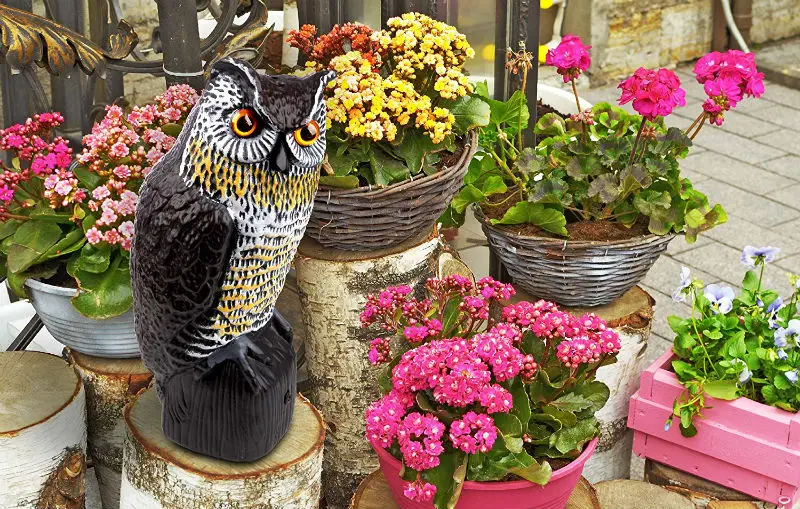
🕊️Noise makers
Noise makers can both be sonic (can be heard by humans) and ultrasonic (can be heard by animals only). Improvised noise makers are cluttering pans hung with ropes will do for those who don’t have the budget for commercial solutions.
If you have the extra budget for your barn, you can utilize ultrasonic repellers. These are outdoor devices that you can mount on the ground using a stake or on any surface, pole, or fence.
Ultrasonic devices will produce high-frequency sounds that birds find disorienting. In addition, this will discourage them from roosting or going near your barn.
For large barns, multiple ultrasonic devices are needed. Also, you have to mount it strategically to cover more ground.
🕊️Scare tactics
Scare tactics include shooting a rifle in the air to scare the flock, attacking the bird with a noise barrage, or hanging a dead pigeon around. This will work at some point, but it has prominent limitations.
The birds will fly away upon hearing the noise. However, they will go back once the place is silent and you’re not around. Worse, they will figure out your scare patterns and adjust their roosting habits based on it.
Also, these tactics can scare even your own barn animals. For those that are raising free-range livestock, this method of driving pigeons away isn’t ideal. It will stress the cows and other livestock, which will defeat the organic and wholesome idea of free-range farming.
🕊️Barn cats
Here’s one good suggestion for barn owners who are tired of chasing pigeons by their selves. They can use a few barn cats to watch over the fields and the barn itself. Cats become feisty when it comes to chasing birds and it’s a great way to discourage the birds from landing on your property.
However, you should know that even barn cats aren’t foolproof. At some point, the cat will get used to the pigeons and stop chasing them or vice versa.
🕊️Chemical repellents
One of the common examples of chemical repellents is a gel known as “tanglefoot” paste. It’s a clear yet sticky substance that discourages pigeons and other birds from roosting on structures and surfaces.
The only problem about this repellent is it sticks to the pigeon’s feathers. It will affect their flight, but if you don’t care about the pigeon’s plight, this one is a great solution.
Some would opt to poison the birds through feeders infused with pesticides. This is a good trick, but like what we said, killing the pigeons isn’t a long-term solution. Most pigeons will flock and replace the ones you killed. It becomes a continuous process.
How to bird proof a barn
Prevention is the key when it comes to bird invasions. We recommend that you bird-proof your barn before the bird season comes in. Here are some of our practical suggestions:
🕊️Interior
Clean and remove any sitting food sources inside the barn and keep it in a sealed container. Also, make sure that the pigeons can’t peck through it. If possible, install screens on open parts of the farmhouse where pigeons may enter. This way, you let the sunlight in without giving the birds a path toward their food source.
🕊️Exterior
Just the same as you did in the interior of the barn, clean up and remove any pigeon attractants. Also, seal any entryways using wood, mesh, or nets.
You should also place visual deterrents like scare tapes and shiny rods all over the place. For barns, spinning roof cowls made from shiny steel are excellent deterrents. It’s shiny, moving, and you can attach a noise maker, so it also produces sounds as its spins.
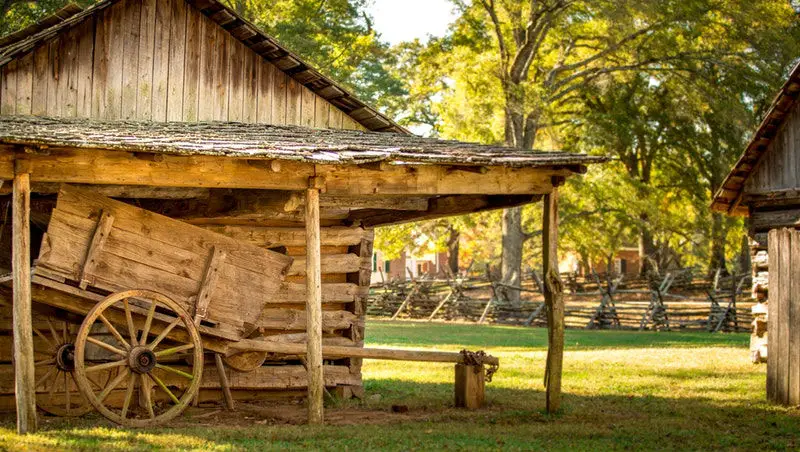
Additional bird proofing tips
🕊️Remove bird feeders
If possible, remove any feeders where the pigeons tend to flock. If you’re feeding beneficial birds, use closed feeders that will void access to pigeon and other large birds.
Also, place the feeders away from your plants and crops. This way, you can divert the pigeons off your vegetation and reduce any potential damages.
🕊️Discourage nesting
Pigeons may nest on your barn and attract more flocks. It’s best to discourage nesting by installing spikes on eaves or install sloping eaves instead.
Take note that pigeons fancy flatter surfaces when nesting. This is why they prefer rafters than eaves. You should block these parts of the barn to discourage the nesting phase.
🕊️Use pigeon birth control
Pigeon birth control products are bait systems used to terminate the reproduction of the pigeons. This way, the flocks will be controlled and soon enough, the population will be eradicated. Also, this cuts the need to cull the birds.
One of the most popular pigeon birth control brands is OvoControl P, which removes the need to poison the pigeons.
What to avoid
One thing that you shouldn’t do is stopping to protect your barn from birds. Although pigeons may fly away after the season, other pesky birds may take over and wreak havoc on your farm. The likes of crows, starlings, swallows, and woodpeckers are all destructive. You’d never want to put your guard down.
Also, never kill pigeons unless you check with the state and federal laws. Specific states have wildlife acts in place which prohibits the killing or disturbance of pigeon nests. Doing some research will save you from legal entanglements.
Final words
Knowing how to get rid of pigeons in a barn can be challenging. You have to employ the right control methods to ensure that the pigeons won’t cause expensive damages to your property. With that, we hope that or tips and suggestions help you manage the bird invasion.
Do you have something to add? Have you experienced pigeon invasion on your barn? Let us know below!

